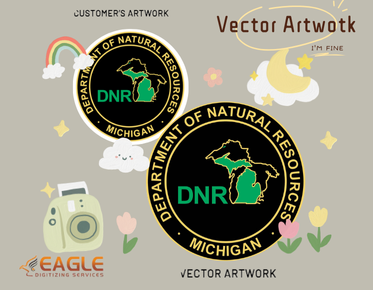Vector Export Guide: Ensure Quality and Compatibility
Creating visually stunning and technically sound vector graphics is one thing, but ensuring their quality across platforms requires skill in exporting. The process of exporting vector graphics—whether for print, web, or social media—demands a careful balance between maintaining fidelity and adapting to the requirements of different formats. In this article, we’ll explore the crucial steps and best practices for exporting vector graphics while maintaining optimal quality and ensuring platform compatibility. Read Here are Some Crucial Aspects That You Ought to Know About vector artwork service!
Preparing Your Vector File for Export
Cleaning Up Your Design Before Export
Before you export your vector graphic, it’s essential to tidy up your design. Remove any stray anchor points, hidden layers, or unnecessary objects that may complicate the export process. Simplifying paths can also help reduce the file size without compromising the design. This clean-up not only streamlines the export process but also prevents issues like bloated file sizes or artifacts that could degrade the final output.
Organizing Layers for a Seamless Export
Organized layers are key to a seamless export. Group related elements, label layers clearly, and ensure that all effects and styles are applied consistently. Keeping your layers in order not only makes it easier to edit your design later but also helps maintain compatibility when exporting to different formats, ensuring that nothing gets lost in translation.
Choosing the Right File Format
Overview of Popular Vector Formats: AI, EPS, SVG
Choosing the right file format is crucial for both quality and compatibility. Adobe Illustrator (AI) files are perfect for maintaining the full editability of your design, especially for future revisions. Encapsulated PostScript (EPS) is a more versatile format, often used for sharing files between different vector software programs while preserving the design’s integrity. Scalable Vector Graphics (SVG) are widely used for web-based applications due to their small file size and ability to retain quality when scaled.
When to Use Raster Formats: PNG, JPEG, and TIFF
There are times when raster formats like PNG, JPEG, or TIFF are necessary—such as when dealing with web or social media posts. While these formats convert your vectors into pixels, they’re often required for platforms that don’t support vector files. PNG is ideal for images that need transparent backgrounds, while JPEG works well for images with a wide color range but no transparency. TIFF is preferred for high-quality print images, although its file size tends to be much larger.
Export Settings Demystified
Key Export Settings Explained
The export settings you choose can make or break the quality of your final output. Pay attention to anti-aliasing options to ensure smooth edges, and always choose vector-based output when exporting to formats like PDF or SVG. Additionally, ensuring that you select the correct bit depth (8-bit, 16-bit) can significantly impact the quality, especially when dealing with detailed gradients or complex effects.
Understanding Resolution and DPI
Resolution plays a huge role in how your exported vector looks, especially when converting to raster formats. For digital screens, 72 DPI (dots per inch) is the standard, but for print, you’ll need a higher resolution—typically 300 DPI—to ensure crisp, clear results. Choosing the appropriate resolution at export ensures your design doesn’t appear blurry or pixelated when viewed on different devices or printed materials.
Optimizing for Different Platforms
Web vs. Print: What’s the Difference?
Web and print platforms have vastly different requirements. Web exports need to be optimized for speed and responsiveness, meaning smaller file sizes without sacrificing too much quality. Conversely, print exports need to be high-resolution, with precise color management and no compression artifacts. Understanding the end use of your graphic helps you tailor your export settings for the best possible results in each medium.
Exporting for Social Media: Best Practices
Social media platforms each have their own optimal image sizes and formats. Exporting vector graphics for social media typically involves converting to PNG or JPEG formats, with dimensions that align with platform requirements (e.g., Instagram prefers square images, while Twitter favors landscape). Compression plays a key role here—keeping file sizes low ensures faster load times without compromising visual quality.
Setting Color Profiles
The Importance of Color Management
Color management ensures that the colors in your design look the same across all platforms. Using the correct color profile during export prevents color shifts that can occur between devices or media. For example, what looks vibrant on your screen might appear dull when printed if the wrong profile is used. Proper color management is essential to maintaining the integrity of your design.
Choosing Between RGB and CMYK
RGB (Red, Green, Blue) is the go-to color mode for digital screens, while CMYK (Cyan, Magenta, Yellow, Key/Black) is used for print. If your design is intended for the web, stick to RGB to maintain brightness and vibrancy. For print, CMYK ensures the colors print accurately. Be sure to set the correct color mode before exporting to avoid unwanted color discrepancies in the final product.
Preserving Text and Fonts
Outlining Text for Compatibility
Text can be tricky when exporting vector files. One way to ensure compatibility across different platforms or programs is by outlining your text. This converts the text into paths, ensuring that it remains intact even if the recipient doesn’t have the fonts you used. However, once outlined, the text is no longer editable, so keep an original version with editable text in case revisions are needed later.
Embedding Fonts vs. Outlining: What You Need to Know
If you prefer to keep your text editable, embedding fonts is another option. This method includes the font file within the exported document, allowing others to access the text without needing the original font. However, embedded fonts can increase file size, and there’s always the risk that some platforms may not support embedded fonts. Weigh the pros and cons based on the intended use of your file.
Managing Effects and Styles
Handling Gradients and Patterns in Exports
Gradients and patterns add depth to your designs, but they can pose challenges during export. When exporting to certain formats, complex gradients or patterns may not render as intended, leading to banding or distortion. To preserve these effects, consider flattening the design or adjusting your export settings to ensure that gradients and patterns maintain their appearance across platforms.
Flattening Layers: Pros and Cons
Flattening layers simplifies your design by merging them into a single layer. This reduces file complexity and ensures that effects, styles, and adjustments are preserved during export. However, once flattened, the layers are no longer editable. While flattening is useful for final exports, especially for print or web, always save a layered version of your file for future revisions.
Testing for Quality
How to Preview Your Exports
Before sending your exported file off, take time to preview it across different devices and platforms. Open the file on various screens (desktop, tablet, mobile) and zoom in to ensure that no details are lost. Previewing your exports helps catch any potential issues with resolution, color, or alignment that might have slipped through the cracks during the export process.
Comparing Exported Files: Quality Checks
After exporting, compare your file to the original vector. Look for discrepancies in color, sharpness, and detail. Check that all layers, effects, and text have been preserved correctly. Quality checks can help you identify whether further adjustments to the export settings are needed, saving you from having to redo the process later.
Adjusting for Screen and Print Differences
Adapting Colors for Different Media
Colors can appear differently on screen versus print, so it’s important to adjust accordingly. Digital screens are backlit, making colors appear brighter and more saturated, while printed materials absorb light, often making colors look duller. Use soft-proofing techniques in your design software to simulate how colors will look when printed, and adjust the saturation or brightness as needed to achieve the desired effect.
Ensuring Crisp Edges in Print
Crisp edges are a hallmark of professional print work. When exporting for print, be sure to use the highest resolution possible and ensure that your vector paths are clean and well-defined. Avoid low-resolution raster images embedded within your vector file, as these can result in blurry edges that undermine the quality of the final print.
Version Control and Backups
Keeping Track of Different File Versions
Version control is crucial when working on complex projects. Label your file versions clearly (e.g., “logo_final_v1,” “logo_final_v2”) and save them in chronological order. This allows you to easily go back to previous versions if needed, reducing the risk of overwriting important files or losing work during the editing process.
Best Practices for Saving Backups
It’s always a good idea to save backups of your design files. Store them on external drives, cloud storage, or version-control systems like Git. Regular backups ensure that if something goes wrong—like a corrupted file or accidental deletion—you won’t lose hours of hard work.
Common Exporting Mistakes to Avoid
Pitfalls in Vector Exports
Common mistakes in exporting vector graphics include forgetting to check resolution settings, exporting with incorrect color profiles, or neglecting to embed fonts. These errors can lead to poor quality in the final output, requiring you to go back and re-export. Avoid these pitfalls by reviewing your settings carefully before exporting.
Troubleshooting Common Issues
If you run into issues like missing fonts, jagged edges, or distorted effects, double-check your export settings. Ensure that the correct file format, resolution, and color profile are selected. If problems persist, try exporting smaller sections of your design to isolate the issue.
Using Compression Wisely
Understanding File Compression
Compression reduces file size, but it can also lower quality. Lossy compression formats like JPEG can introduce artifacts, while lossless formats like PNG or ZIP compression maintain the integrity of the design. Choose your compression method based on the final use of your file, balancing file size with the need for quality.
Balancing Quality and File Size
When exporting for the web or social media, smaller file sizes are often prioritized to ensure fast loading times. However, this shouldn’t come at the expense of visual quality. Adjust your compression settings to find the sweet spot where the file size is reduced without a noticeable loss in quality.
Finalizing Your Exported Files
Naming Conventions for Easy Organization
Adopt a consistent naming convention for your exported files. Include relevant details like the file type, version number, and intended use (e.g., “company-logo_social_v3.png”). This not only makes it easier to locate specific files but also ensures that anyone working with your files understands their purpose.
Creating a Folder Structure for Your Projects
A well-organized folder structure is essential for managing multiple exports. Create separate folders for different versions, platforms (web, print), or file formats (AI, EPS, PNG). This system will save you time and headaches when revisiting older projects or handing files off to clients or collaborators. For the excellent online vector conversion, have no qualms about getting in touch with us.
Mastering the art of exporting vector graphics involves more than just pressing a button. It’s about understanding the nuances of file formats, color profiles, and platform requirements. By following best practices, you can ensure your vector graphics look flawless whether they’re on a business card, a billboard, or a website. Each step in the process—from cleaning up your design to testing for quality—contributes to a polished, professional result. Embrace the opportunity to experiment and refine your export process, and you’ll find yourself producing top-tier designs with ease.



